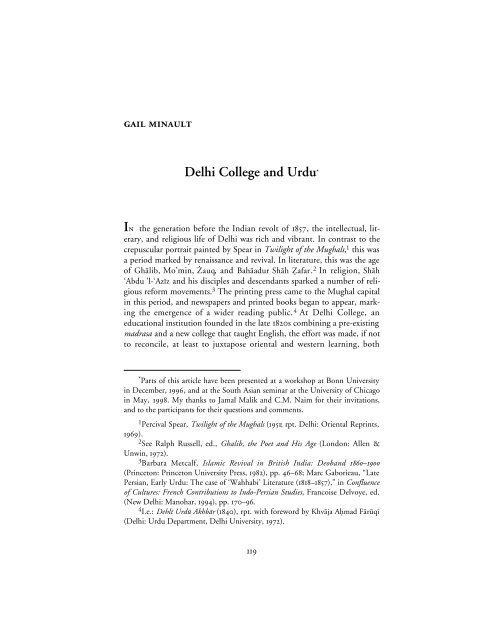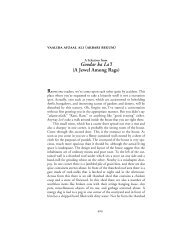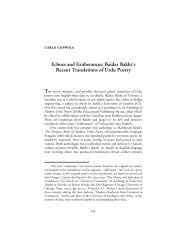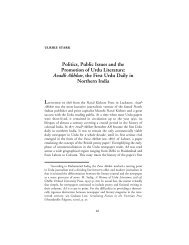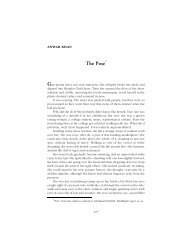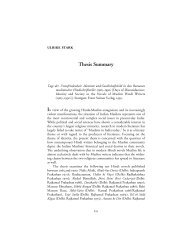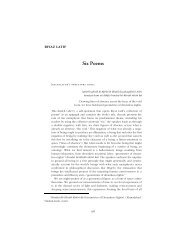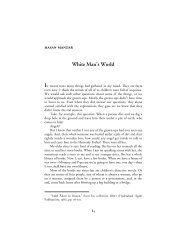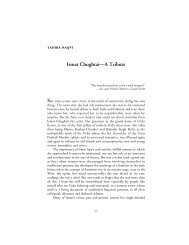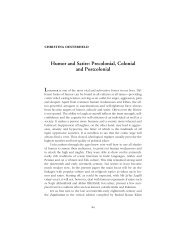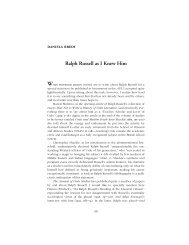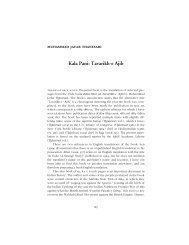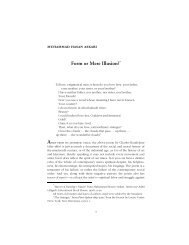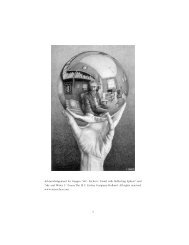Delhi College and Urdu* - MINDS@UW Home
Delhi College and Urdu* - MINDS@UW Home
Delhi College and Urdu* - MINDS@UW Home
Create successful ePaper yourself
Turn your PDF publications into a flip-book with our unique Google optimized e-Paper software.
GAIL MINAULT • 121on printed textbooks that could be mechanically reproduced <strong>and</strong> hencereadily <strong>and</strong> cheaply available for students to read. Orality was being replacedby print, consequently, <strong>and</strong> thus the teacher-student relationship,while still important, was challenged by the vision of the individualscholar, deriving his knowledge from books or scientific observations.Such an individual style of scholarship necessitated the exchange of ideasvia print, in scholarly journals or more popular periodicals. 8Similar to <strong>Delhi</strong> <strong>College</strong>, Urdu was a mediator. For the later Mughalemperors, Urdu had already become a mediating language betweenPersian <strong>and</strong> regional Indian languages, <strong>and</strong> between the imperial court<strong>and</strong> various regional powers. For the British too, Urdu (or Hindustani)filled the need for an Indian vernacular that was more generally understoodthan Persian, but that nevertheless had an association with government<strong>and</strong> incorporated administrative terms <strong>and</strong> concepts. It is importantto remember that, as part of the process that resulted in the establishmentof English as the language of higher administration in India in the nineteenthcentury, the vernaculars also achieved new recognition, utility, <strong>and</strong>importance. At <strong>Delhi</strong> <strong>College</strong>, Urdu was the common language in whichthe dialogue between different curricula, styles of teaching, <strong>and</strong> modes oftransmission of knowledge was carried out. 9The Foundations of <strong>Delhi</strong> <strong>College</strong>The British government in India first began to take responsibility for theeducation of Indian élites following the revision of the East IndiaCompany’s charter in 1813, when a sum was set aside from a projectedsurplus in the annual revenues for the support of education. The particu-8 See, e.g., Dale Eickleman, “The Art of Memory: Islamic Education <strong>and</strong> itsSocial Reproduction,” Comparative Studies in Society <strong>and</strong> History [CSSH], 20:4(Oct. 1978), 485–516; various articles in N. Gr<strong>and</strong>in <strong>and</strong> M. Gaborieau, eds.,Madrasa: La Transmission du Savoir dans le Monde Musulman (Paris: Edns.Arguments, 1997); <strong>and</strong> Francis Robinson, “Technology <strong>and</strong> Religious Change:Islam <strong>and</strong> the Impact of Print,” Modern Asian Studies [MAS], 27:1 (1993), 229–51.9 Muzaffar Alam, “The Pursuit of Persian: Languages in Mughal Politics,”MAS, 32:2 (1998), 317–49; David Lelyveld, “Zub≥n-e Urd∑-e Mu‘all≥ <strong>and</strong> the Idolof Linguistic Origins,” Annual of Urdu Studies [AUS], 9 (1994), 107–17; cf.Sheldon Pollock, “The Cosmopolitan Vernacular,” Journal of Asian Studies [JAS],57:1 (1998), 6–37.
122 • THE ANNUAL OF URDU STUDIESlar clause in the revised charter also brought to a head the debate betweenOrientalists <strong>and</strong> Anglicists within the British Indian administration, for itcalled not only for the “revival <strong>and</strong> improvement of literature[presumably oriental] <strong>and</strong> the encouragement of the learned natives ofIndia,” but also for “the introduction <strong>and</strong> promotion of a knowledge ofthe sciences [presumably western] among the inhabitants of the Britishterritories in India.” 10 This provision in the law remained a dead letteruntil the 1820s, when a revenue surplus actually materialized, <strong>and</strong> whenthe General Committee of Public Instruction [GCPI] was established inCalcutta, followed by local committees in urban centers around India,including <strong>Delhi</strong>.The <strong>Delhi</strong> Committee of Public Instruction, which included bothBritish officials <strong>and</strong> local notables, investigated the state of learning in theMughal capital in the early 1820s <strong>and</strong> reported that there were a numberof madrasas <strong>and</strong> many smaller schools in the city, but that many of themwere in a state of serious decline. 11 Among them was the Madrasa ofGh≥zµu ’d-Dµn Kh≥n, built in the early eighteenth century just outside<strong>Delhi</strong>’s Ajmeri Gate. The Madrasa was a h<strong>and</strong>some late Mughal edifice,in the familiar red s<strong>and</strong>stone of Shahjahanabad, consisting of a mosque<strong>and</strong> a two-storied arcade that contained rooms for the teachers <strong>and</strong> students<strong>and</strong> enclosed a courtyard, entered by a massive gateway. Adjacent tothe mosque was the marble tomb of the founder, Gh≥zµu ’d-Dµn Kh≥nFµråz Jag, a nobleman who had served the Mughal emperor Aurangzebin the Deccan <strong>and</strong> who was the father of the man who became the firstNizam of Hyderabad. In his will, Gh≥zµu ’d-Dµn Kh≥n had established avaqf for the support of the madrasa. Like many such endowments, itprovided stipends not only for the teachers but also the students. 12By the early nineteenth century, the income from the original vaqf ofGh≥zµu ’d-Dµn Kh≥n had declined, as had the student body, <strong>and</strong> themadrasa was in disrepair. 13 About this time, the <strong>Delhi</strong> Committee ofPublic Instruction took an interest in this institution. In the mid-1820s,10 H. Sharp, ed., Selections from Educational Records, Pt. I (1920; rpt. New<strong>Delhi</strong>: National Archives of India, 1965), p. 22.11 Board Collections [BC], #s 25694–25695, 1826–27, Vol. 909, pp. 487–91,540–53, 565. India Office Library & Records [IOLR].12 J.H. Richey, ed., Selections from Educational Records, Pt. II (1922; rpt. New<strong>Delhi</strong>: National Archives of India, 1965), pp. 252–3.13 BC, #s 25694–95, 1826–27, Vol. 909, p. 565 ff. IOLR.
GAIL MINAULT • 123they obtained a grant from the general education fund for the support oforiental learning at the madrasa. In 1827, the government sanctioned anadditional sum, supplemented by funds raised locally, to start Englishclasses <strong>and</strong> teach astronomy <strong>and</strong> mathematics “on European principles” atthe school. About this time, the Madrasa of Gh≥zµu ’d-Dµn Kh≥n began tobe called <strong>Delhi</strong> <strong>College</strong>, with an oriental section (the madrasa), whereArabic <strong>and</strong> Persian grammar, literature, <strong>and</strong> other Islamic subjects (‘ul∑m)were taught, <strong>and</strong> an anglo-vernacular section (or institution), wherewestern subjects were taught. In both sections, the medium of instructionwas Urdu. 14Then in 1828 or 1829, Nav≥b I‘tim≥du ’d-Daula, a minister at the courtof Awadh, established a new vaqf, specifying that the income from theendowment should go to the support of oriental learning in his nativecity, <strong>Delhi</strong>. He asked the East India Company to administer this endowment,indicating that—less than a decade before the Anglicize triumphalismof Macaulay’s famous Minute on Education—North Indian notablesfelt no cultural threat from the British administration’s educationalpolicies. The GCPI thanked the Nav≥b for his “munificent donation” <strong>and</strong>suggested that—rather than found another institution—the income fromhis endowment could best be spent supporting the existing <strong>Delhi</strong>madrasa. The local committee in <strong>Delhi</strong> applied the funds from theNav≥b’s vaqf to the account of the oriental section of <strong>Delhi</strong> <strong>College</strong>, <strong>and</strong>reassigned part of the government funds to the anglo-vernacular sectionof the college. 15By the mid-1830s, power on the GCPI in Calcutta had shifteddefinitively in favor of the Anglicists, leading to Macaulay’s Minute withits famous line about the formation of “a class of persons, Indian in blood<strong>and</strong> color, but English in taste, in opinions, in morals, <strong>and</strong> in intellect”that has been quoted ever since. He firmly rejected further support fororiental education, <strong>and</strong> opined that, even at those oriental institutionsthat survived the government’s change in policy, stipends to studentsshould cease. 16In <strong>Delhi</strong>, the new policies emanating from Calcutta resulted in thecancellation of a number of student stipends. What’s more, the Principal14 MDK, pp. 22–23, 32–33; Sharp, pp. 188–9.15 <strong>Home</strong> (Pub) file # 8–14 & KW (15 July 1840), National Archives of India[NAI].16 Sharp, p. 116.
124 • THE ANNUAL OF URDU STUDIESof <strong>Delhi</strong> <strong>College</strong>, J.H. Taylor, using some creative book-keeping, hadbeen using funds from the Nav≥b’s vaqf to meet expenses in both sectionsof the college, resulting in a further cut in support to the oriental section.The local committee, fighting against Calcutta’s policies, protested thatthe state had “greatly injured the interests of the institution.” It also investigatedTaylor’s actions, expressing doubts that “the wishes of theNav≥b have been fulfilled,” <strong>and</strong> reprim<strong>and</strong>ed him for damaging “one ofthe few public colleges left to the people in which Oriental Literature isstill being taught under the patronage of the British Government.” 17Sir James Thomason, who later became Lieutenant-Governor of theNorthwestern Provinces, emphasized <strong>Delhi</strong> <strong>College</strong>’s unique character:The Oriental <strong>College</strong> in <strong>Delhi</strong> … occupies a prominent part in theeyes of a large <strong>and</strong> influential body of the native community, whom it ismost important to convince of our liberality <strong>and</strong> sincerity … Great <strong>and</strong>successful exertions had been made [by those connected with the collegelocally], <strong>and</strong> these it would be unjust <strong>and</strong> unwise to disappoint. 18Among the local notables who supported the college was Muftµ ¿adru ’d-Dµn Kh≥n “¥zurda,” the ¿adru ’Ω-¿ud∑r (chief judge) of <strong>Delhi</strong>, a memberof the local committee of public instruction, <strong>and</strong> a poet who hosted oneof the most illustrious literary salons of the city. ¥zurda’s mush≥‘iras regularlyfeatured the artistry of Gh≥lib, Mo’min <strong>and</strong> other poets. 19 The localgovernment had no desire to offend figures of such eminence.The government in Calcutta took some remedial action, allowingsome support for “efficient” oriental learning, <strong>and</strong> following up the reprim<strong>and</strong>of Taylor by replacing him as Principal with an Orientalistscholar, Felix Boutros, who had the advantage of knowing the languageshe was supposed to be supervising. Boutros is mentioned in the sources asa French scholar of Arabic, but his name suggests that he was an ArabChristian from either Egypt or the Levant who had been educated in17 Letter from Lt. Robinson to J.H. Taylor, d. <strong>Delhi</strong>, 15 March 1839. <strong>Home</strong>(Pub), 8–14 & KW (15 July 1840), NAI.18 Richey, p. 257.19 ‘Abdu ’r-Ra√man Parv≥z IΩl≥√µ, Muftµ ¿adru ’d-Dµn ¥zurda: ƒay≥t,ShakhΩiyat, ‘Ilmµ aur Adabµ K≥rn≥m® (New <strong>Delhi</strong>: Maktaba-e J≥mi‘a, 1977), pp.33–8, 47–51.
GAIL MINAULT • 125France. 20Under Boutros <strong>and</strong> his successor as Principal, Dr. Aloys Sprenger,<strong>Delhi</strong> <strong>College</strong> developed a high reputation as a center of learning in theMughal capital, <strong>and</strong> as an arena of dialogue between eastern <strong>and</strong> westerncurricula, carried out in Urdu. This was a phenomenon that Macaulay’sgr<strong>and</strong>iloquent minute did not foresee. The Orientalist-Anglicist controversyenvisaged either traditional, religiously-based literary learning or elsewestern learning in English, but not a combination of the two withinstruction in a modern Indian language. This successful experiment wasmade possible by the many learned men of talent who participated asteachers, students, <strong>and</strong> administrators. Muftµ ¿adru ’d-Dµn ¥zurda servedon the local committee, as did Saiyid ƒ≥mid ‘Alµ Kh≥n, the nephew <strong>and</strong>heir of Nav≥b I‘tim≥du ’d-Daula. The local committee originally hoped toemploy a disciple of Sh≥h ‘Abdu ’l-‘Azµz as the head Arabic teacher, 21showing that there was no animosity between at least one branch of theSh≥h’s lineage <strong>and</strong> the British administration. By the early 1830s, theArabic teacher was Maml∑k ‘Alµ N≥nautavµ, a distinguished Islamic scholarfrom a lineage that later produced the founder of the Deob<strong>and</strong> school. AsPersian teacher, the committee hired Im≥m Bakhsh “¿ehb≥'µ,” who haddistinguished himself as a tutor to a number of leading families in thecity. 22The poet Gh≥lib was also a c<strong>and</strong>idate for the Persian post at <strong>Delhi</strong><strong>College</strong>, but failed to get it because of a famous misunderst<strong>and</strong>ing. Gh≥libarrived for the interview in his palanquin, but when Thomason, who wasconducting the interviews, failed to come out to the curb to receive thepoet—did not greet him, in other words, in the way Gh≥lib felt befitting—hedid not go through with the interview, but left in a huff. 23Thomason explained to the poet that he was bound by regulations. If thiswere a darb≥r, a formal welcome would be in order. In such courtly20 Sharp, pp. 150–1; MDK, pp. 154–5; cf. <strong>Home</strong> (Pub), 8–14 & KW (15 July1840), NAI.21 This was Maulvµ Rashµdu ’d-Dµn Kh≥n. The records are incomplete in the1820s, <strong>and</strong> he may have been employed at the Madrasa in that period. BC #s25694–95, 1826–27, Vol. 909, pp. 551–52, IOLR.22 Khv≥ja Mu√ammad ƒ≥mid, “Im≥m Bakhsh ¿ehb≥’µ,” Nav≥’-e Adab, 14:1(Jan. 1963), 14–33.23 Ralph Russell <strong>and</strong> Khurshidul Islam, Ghalib: Life <strong>and</strong> Letters (London:Allen & Unwin, 1969), pp. 62–3.
126 • THE ANNUAL OF URDU STUDIESrituals, the British still held to Mughal forms, but not in interviews foremployment. This anecdote could simply be an amusing reflection of thepoet’s problematic relationship with the British. It was not an easy one,<strong>and</strong> Gh≥lib never fully received what he felt was his due. His pride, <strong>and</strong> adisjunction between what he <strong>and</strong> his British interlocutor felt was properetiquette, got in the way of his securing a post at the college. 24 Im≥mBakhsh was presumably more accommodating.Translating CulturesNotwithst<strong>and</strong>ing such episodes, the fact remains that Orientalist scholars,British administrators, <strong>and</strong> local literati <strong>and</strong> notables were all part of making<strong>Delhi</strong> <strong>College</strong> what it was. Its creative role included not only instruction,but also translation, publication, <strong>and</strong> popularization.Vernacularization, making more knowledge available to more people, wasessential to these processes. Macaulay had disparaged the “vernacular dialects”as being unfit “vehicles for conveying knowledge.” His opinion,both uninformed <strong>and</strong> condescending, nevertheless foresaw the need fortranslation <strong>and</strong> adaptation. In the development of textbooks <strong>and</strong> otherforms of scholarly prose, <strong>Delhi</strong> <strong>College</strong> was at the center of a major effortof translation, further evidence of its mediating role.This linguistic mediation involved translating texts into Urdu out ofArabic, Persian, <strong>and</strong> Sanskrit for the oriental section, <strong>and</strong> out of English<strong>and</strong> other western languages for the anglo-vernacular section. Translation,however, is an inexact science, dependent on the skill of persons who mayknow one language better than the other, on varying interpretations ofmeaning, <strong>and</strong> upon teamwork that is sometimes in short supply.Translation can betray, as well as convey, meaning. What concepts weretranslated <strong>and</strong> what was understood by readers of the texts are mattersthat are not easy to decipher. Nevertheless, to obtain adequate textbooks,the college had to initiate the task.In the early 1840s, Principal Boutros started the VernacularTranslation Society, following the earlier example of the Calcutta BookSociety but at a more advanced level. The society translated textbooks inmedicine, law, science, economics, <strong>and</strong> history from English into Urdu.24 Cf. Peter Hardy, “Ghalib <strong>and</strong> the British,” in Russell, ed., Ghalib, the Poet<strong>and</strong> His Age, pp. 54–69.
GAIL MINAULT • 127Teachers <strong>and</strong> students both participated in the work of translation, creatingtheir own textbooks in the process—an interesting blending of theoral <strong>and</strong> written traditions. Individual local benefactors helped financethe first translations <strong>and</strong> publications; then sales of texts helped the effortalong. Publications appeared from a number of local presses <strong>and</strong> eventuallyfrom the college’s own press, the Maπba‘u ’l-‘Ul∑m. The governmentalso agreed to finance the translation of math <strong>and</strong> geometry texts in orderto bring western sciences to students in the oriental section. 25The list of the society’s publications includes basic textbooks such asEuclid’s geometry (which had been a part of the Arabic as well as thewestern curriculum), <strong>and</strong> histories of Engl<strong>and</strong>, Greece, <strong>and</strong> Rome, <strong>and</strong>the geography of India. Science texts included both “natural philosophy”<strong>and</strong> y∑n≥nµ πibb (also from Arabic). Translation of oriental classics fromPersian, Arabic, <strong>and</strong> Sanskrit included Sa‘dµ’s Gulist≥n, selections fromThe Thous<strong>and</strong> <strong>and</strong> One Nights, Laila <strong>and</strong> Majnun, <strong>and</strong> the DharmaShastras. 26 The Vernacular Translation Society, therefore, made it possiblefor students of <strong>Delhi</strong> <strong>College</strong> to participate in both “the revival <strong>and</strong>improvement of literature” <strong>and</strong> “the promotion of the knowledge of thesciences,” without any apparent conflict between the two goals. Althoughthe two sections of the school remained discrete, the Orientalist-Anglicistcontroversy seemed to be much less salient in the Mughal capital citythan it did in the chambers of government in Calcutta.The study of western sciences such as astronomy <strong>and</strong> calculus was ingreat dem<strong>and</strong> among the students of the college, including those in theoriental section. <strong>Delhi</strong> <strong>College</strong> students were cognizant of the Copernicanrevolution, 27 even though most did not study English literature or west-25 MDK, pp. 127–47; Khv≥ja A√mad F≥r∑qµ, Ÿauq-o-Justaj∑ (Lucknow: Id≥raeFarågh-e Urd∑, 1967), pp. 233–91; Inti ≥r Mirz≥, “Qad≤m Delhµ K≥l®j kµ AdabµKhidam≥t k≥ J≥’iza,” Diss. <strong>Delhi</strong> University, Department of Urdu, 1984.26 MDK, pp. 148–53; Report of the GCPI, Bengal for 1840/41–1841/42, App.XV by Boutros, d. <strong>Delhi</strong>, 1 July 1842, IOLR, V/24/948.27 In fact, Newton’s Principia <strong>and</strong> other works of European mathematics <strong>and</strong>astronomy that supported the heliocentric view of the universe had already beentranslated into Arabic <strong>and</strong> Persian in India in the late eighteenth century byMaulvµ Tafa¤¤ul ƒusain Kh≥n of Lucknow. He is mentioned in the Asiatick AnnualRegister of 1803, pp. 1–8; <strong>and</strong> in Ab∑ ∫≥lib Kh≥n, Ma’¡ir-e ∫≥libµ (personalcommunication between the author <strong>and</strong> M. Tavakoli-Targhi). Cf. Tavakoli-Targhi, “Orientalism’s Genesis Amnesia;” <strong>and</strong> C.A. Bayly, “Colonial Star Wars:
128 • THE ANNUAL OF URDU STUDIESern philosophy. There are several reasons for this that have little or nothingto do with religious prejudice or cultural resistance. The main reasonwas that in <strong>Delhi</strong> at that time, a knowledge of English was not a requirementfor government service. Even after Persian was disestablished in themid-1830s, Urdu was officially used in the local courts. Knowledge ofPersian remained the mark of a man of culture, Urdu the language ofeveryday discourse <strong>and</strong>, increasingly, of government <strong>and</strong> public business.Hence a traditional literary education, plus—to be sure—some personalconnections, were sufficient to gain access to government service. Many<strong>Delhi</strong> <strong>College</strong> students, of whatever religion, were willing to learn tospeak some English, if only as a useful means of communication withtheir rulers. If they pursued literary studies, however, they usually did soin the classical languages of Arabic, Persian, <strong>and</strong> Sanskrit.The curriculum at the college shows that the distinction betweenoriental <strong>and</strong> western learning, while maintained organizationally, was lessclear in practice. Indeed, Boutros hoped to make the annual exams comparablein all subjects—except literature—for the students of bothsections of the college. In the oriental madrasa, senior Arabic students ofMaul≥n≥ Maml∑k ‘Alµ were examined on the Dµv≥n of Mutanabbµ, theMaq≥m≥t of ƒarµrµ, <strong>and</strong> excerpts from Alf Laila (The 1001 Nights), ongrammar <strong>and</strong> composition, <strong>and</strong> on their ability to translate Arabic worksinto Urdu (some of which were then published by the TranslationSociety). Students of Persian studying with Maulvµ Im≥m Bakhsh were examinedon the Insh≥’-e Abu ’l-Fa¤l (a manual of correspondence by theMughal historian), the Sik<strong>and</strong>arn≥ma of Ni ≥mµ (tales of Alex<strong>and</strong>er theGreat), plus grammar, composition, <strong>and</strong> translation into Urdu. Inhistory, they read the T≥rµkh-r Tµm∑rµ (History of Timur), in geography,the Mir’atu ’l-Aq≥lµm (A Reflection of the Climes), both in Urdu. In law,Sunni students read the Hid≥ya (a digest of ƒanafµ fiqh); <strong>and</strong> Shi‘as readSharµ‘atu ’l-Isl≥m <strong>and</strong> Naf√atu ’l-∂m≥n(digests of Shi‘a fiqh). In math, themadrasa students studied the Urdu translation of Brown’s arithmetic, ast<strong>and</strong>ard textbook of the day, <strong>and</strong> in geometry—predictably—Euclid. Inthe Sanskrit classes, an experiment to teach math via the Lilavati (a mathematicalportion of Bhaskara’s Siddhanta Shiromani) did not succeed.Students complained that it was too difficult to learn both Bhaskara’sSanskrit <strong>and</strong> math simultaneously; the teachers agreed <strong>and</strong> turned toThe Politics of the Heavens in India” (draft in author’s possession, courtesy ofC.A. Bayly).
GAIL MINAULT • 129math textbooks. Other subjects included logic, principles of naturalphilosophy, principles of legislation <strong>and</strong> of political economy, <strong>and</strong> thehistory of India. 28The curriculum of the English institution included many of the samesubjects. The students learned English <strong>and</strong> Urdu grammar <strong>and</strong> composition,<strong>and</strong> read literary selections. Urdu classes included instruction fromPlatt’s Grammar of Hindustani, <strong>and</strong> readings from Mµr Amman’s B≥gh-o-Bah≥r (Tale of Four Dervishes), <strong>and</strong> Anv≥r-e Suhailµ (Animal Fables). InEnglish, lower classes read from Richardson’s Selections of poetry <strong>and</strong>prose, Bacon’s Essays, <strong>and</strong> Shakespeare’s Macbeth or Hamlet. Upper classestackled Milton’s Paradise Lost, Shakespeare’s Tempest <strong>and</strong> Richard III,more of Bacon’s Essays, Gibbon’s Decline <strong>and</strong> Fall of the Roman Empire,<strong>and</strong> Adam Smith’s Wealth of Nations. Apart from English classes, thetextbooks were Urdu translations of basic texts of that time: Goldsmith’shistories of Engl<strong>and</strong>, Greece, <strong>and</strong> Rome, Marshman’s history of India,Mill’s political economy, Macnaughton on Hindu <strong>and</strong> Muslim law,principles of social legislation—UΩ∑l Qav≥’idu ’l-Akhl≥q—compiled fromthe works of Bentham, Prinsep’s abstract of civil regulations, Whately’slogic <strong>and</strong> rhetoric, <strong>and</strong> general works on geography <strong>and</strong> agriculture. Inmathematics, Brown’s arithmetic textbook, Euclid’s geometry (aconstant), <strong>and</strong> the principles of algebra, calculus, <strong>and</strong> plane trigonometrywere taught to various classes. The lower classes were also instructed indrawing <strong>and</strong> surveying. In science, in addition to general natural philosophy<strong>and</strong> physiology, other textbooks on the list of translations includedHerschel’s astronomy, a manual of chemistry by O’Shaughnessy, <strong>and</strong>Goldsmith’s animated nature (zoology). 29The Impact of Print28 MDK, pp. 81–102; Report of the GCPI, NWP for 1843–44, Apps. N <strong>and</strong>R by Boutros; Report of the GCPI, NWP for 1844–45, pp. 73–76, App. A, IOLR,V/24/905.29 Ibid., In comparing lists of works in MDK <strong>and</strong> reports of the GCPI, it isnot always clear whether lists of works translated by the Vernacular TranslationSociety, as reported by Boutros, represent aspirations or accomplishment. MDK’slists of curricula seem more definite; these reflect the GCPI reports, withmodifications over the years.
130 • THE ANNUAL OF URDU STUDIESIn the generation between 1827 <strong>and</strong> 1857, hundreds of students, Hindu,Muslim, <strong>and</strong> a few Christians, 30 attended <strong>Delhi</strong> <strong>College</strong>. They studiedwith the teachers already mentioned, <strong>and</strong> many went on to becometeachers at the college themselves. They worked under the aegis of thevarious principals: J.H. Taylor (whom we encountered above), FelixBoutros (who replaced Taylor <strong>and</strong> who was the moving spirit behind thetranslation effort), <strong>and</strong> then Dr. Aloys Sprenger, a medical doctor fromthe Tyrol who had joined the Bengal medical service in order to pursuehis other, more compelling interest—Arabic <strong>and</strong> Persian philology—via acareer in India. Dr. Sprenger was especially influential in the developmentof publications at the college press. In 1845, he founded a journal at thecollege that he called Qir≥nu ’s-Sa‘dain, or “The Conjunction of Two[Fortunate] Planets,” an Arabic astrological term denoting the conjunctionof Jupiter <strong>and</strong> Venus, but also a metaphor for a successful collaboration.The reference to the interaction of two cultures, East <strong>and</strong> West, inthe mission of the college, is clear. 31Qir≥nu ’s-Sa‘dain, was only one of the journals published by the college,<strong>and</strong> it did not survive for long. Another, that enjoyed a longer run,was the Khairkhv≥h-e Hind (renamed the Mu√ibb-e Hind ), edited byMaster Ramch<strong>and</strong>ra. Ramch<strong>and</strong>ra, a Kayastha who eventually convertedto Christianity, was a math professor at <strong>Delhi</strong> <strong>College</strong> <strong>and</strong> intellectuallyone of its leading lights. 32 He wrote an original treatise on algebra that30 Enrollment figures taken from GCPI reports are cited in MDK. In 1845,for example, there were 460 students, 215 in the Oriental section (75 studyingArabic, 109 Persian, <strong>and</strong> 31 Sanskrit), <strong>and</strong> 245 in the Anglo-Vernacular section.Of these, 299 were Hindu, 146 Muslim, <strong>and</strong> 15 Christian (p. 46). In 1853, therewere only 320 students, 121 in the Oriental section (Arabic 39, Persian 57, Sanskrit25), <strong>and</strong> 199 in the Anglo-Vernacular. Of these, 217 were Hindu, 93 Muslim, <strong>and</strong>10 Christian (p. 55).31 On Sprenger, see MDK, pp. 155–56; Obituary in Journal of the Royal AsiaticSociety [JRAS] (April 1894): 394–95; <strong>and</strong> M. Ikram Chaghatai, “Dr. AloysSprenger (1813–1893): His Life <strong>and</strong> Contribution to Urdu Language <strong>and</strong> Literature,”Iqbal Review, 36:1 (1995), 77–99.32 On Ramch<strong>and</strong>ra, see MDK, pp. 168–72; Edwin Jacob, A Memoir of ProfessorYesudas Ramch<strong>and</strong>ra (Kanpur: Christ Church Mission Press, 1902); ¿adµqu’r-Ra√m≥n Qidv≥’µ, M≥sªar R≥m±<strong>and</strong>r≥ (<strong>Delhi</strong>: Department of Urdu, <strong>Delhi</strong> University,1961); Sayyida Ja‘far, M≥sªar R≥m±<strong>and</strong>r≥ aur Urd∑ Na¡r k® Irtiq≥’ m® Unk≥ƒiΩΩa (Hyderabad: Abul Kalam Azad Oriental Research Institute, 1960).
GAIL MINAULT • 131received favorable notice in Europe <strong>and</strong> ultimately earned him an awardfrom the government. In his writing <strong>and</strong> editing of Mu√ibb-e HindRamch<strong>and</strong>ra gave evidence of a voracious <strong>and</strong> eclectic mind that, in addition,reflected the ideas <strong>and</strong> books that were being discussed at <strong>Delhi</strong><strong>College</strong> <strong>and</strong> in intellectual circles in <strong>Delhi</strong> in the 1840s. 33 Some of thetitles of articles written by Ramch<strong>and</strong>ra that appeared in the pages ofMu√ibb-e Hind exemplify the range of topics: “The Divisibility ofMatter—A Strange Description from the Researches of EuropeanScientists <strong>and</strong> Scholars” [“‡k ƒ≥l-e ‘Ajµb ƒukm≥y≥n-aur ‘¥qil≥n-e Y∑rap kµTa√qµq≥t m® s®”]; “A Description of a Diving Bell by which meansThings Sunken in the Sea may be Retrieved” [“Ÿikr-e ∆≥’®vig Bel, jis s®∆∑b≥ Huv≥ Asb≥b Sam<strong>and</strong>ar s® Nik≥l Sak®”]; articles on astronomy, onthe work of Sir Isaac Newton, <strong>and</strong> a discussion of human reason [ins≥n kµ‘aql k≥ bay≥n].Ramch<strong>and</strong>ra also included articles about ancient Greece (“OnDemosthenes”), <strong>and</strong> about other Asian cultures (“On Confucius”), <strong>and</strong>serialized translations of Lane’s The Manners <strong>and</strong> Customs of the ModernEgyptians <strong>and</strong> of a biography of Sh≥h ‘Abb≥s of Iran. Other serializationsincluded Vernacular Translation Society publications such as a history ofEngl<strong>and</strong> [Tarµkh-e Inglist≥n] <strong>and</strong> Elphinstone’s The Kingdom of Caubul,<strong>and</strong> original publications from the college press, such as Tarµkh-e Y∑sufµ,the travels of Y∑suf Kh≥n Kambalpåsh to Engl<strong>and</strong>. Ramch<strong>and</strong>ra alsodiscussed new technologies of agriculture <strong>and</strong> irrigation, <strong>and</strong> summarizedworks of history <strong>and</strong> popular science. One of the regular features in thisperiodical, devoted largely to dissemination of new knowledge about East<strong>and</strong> West, was a selection of Urdu poetry derived from accounts of localmush≥‘iras. This was evidence that relations between the college <strong>and</strong> localliterati were still good. 34The development of Urdu as a language of public discourse <strong>and</strong>33 Ramch<strong>and</strong>ra, A Treatise on Problems of Maxima <strong>and</strong> Minima Solved byAlgebra (London: Wm. H. Allen & Co., 1859); cf. Dhruv Raina <strong>and</strong> S. IrfanHabib, “Cultural Foundations of a Nineteenth-Century Mathematical Project,”EPW, 24:37 (16 Sept. 1989), 2082–6.34 Qidv≥’µ, M≥sªar R≥m±<strong>and</strong>r≥, app., pp. 178–94; F≥r∑qµ, pp. 233–91; S. IrfanHabib <strong>and</strong> Dhruv Raina, “The Discourse on Scientific Rationality: A Study ofMaster Ramch<strong>and</strong>ra, in T. Niranjana, P. Sudhir, <strong>and</strong> V. Dhareshwar, eds., InterrogatingModernity (Calcutta: Seagull, 1993), pp. 348–68; Mu√ibb-e Hind, Nos.14–37 (some Nos. missing), (Sept. 1848–Aug./Sept. 1850), IOLR.
132 • THE ANNUAL OF URDU STUDIEStransmission of knowledge in print occurred, in part, thanks to personalitiesassociated with <strong>Delhi</strong> <strong>College</strong> directly or indirectly. Sir Sayyid AhmadKhan, the founder of Aligarh <strong>College</strong>, is sometimes erroneously namedamong the graduates of <strong>Delhi</strong> <strong>College</strong>, perhaps because his first schemefor Aligarh was patterned after the two sections, <strong>and</strong> the Urdu medium,of the <strong>Delhi</strong> institution. He did not study there but did collaborate withMaulavµ Im≥m Bakhsh, Persian teacher at the college, on a study of thetopography of <strong>Delhi</strong>, ¥¡≥ru ’Ω-¿an≥dµd, which remains a leading source onthe condition of the old city before much of it was destroyed during <strong>and</strong>after the 1857 revolt. 35 Maul≥n≥ Maml∑k ‘Alµ N≥nautavµ, Arabic teacher atthe college, had among his students <strong>and</strong> descendants scholars who eventuallyfounded the madrasa at Deob<strong>and</strong>. 36 <strong>Delhi</strong> <strong>College</strong> was thus, in nosmall measure, the precursor of the two supposedly opposing centers ofIndo-Muslim cultural revival <strong>and</strong> reform in the late nineteenth century:Aligarh <strong>and</strong> Deob<strong>and</strong>.The role of the college in the literary life of the Mughal capital wassignificant. The relationship of Muftµ ¿adru ’d-Dµn ¥zurda to the localcollege committee has already been noted. The Muftµ took part inexamining advanced students in Urdu <strong>and</strong> Persian, <strong>and</strong> the more skilledamong them gained access to his literary salon. The college press <strong>and</strong> itspublications were respected in the city. Maulvµ Mu√ammad B≥qir, founderin 1836 of one of the first Urdu newspapers in <strong>Delhi</strong>, the Dehlµ Urd∑Akhb≥r, printed a number of the Vernacular Society’s translations in hispress <strong>and</strong> sent his son, Mu√ammad ƒusain ¥z≥d, to the college. 37 MohanLal Kashmiri, who studied surveying at the college <strong>and</strong> was one of its firstgraduates, accompanied Burnes to Bukhara <strong>and</strong> contributed to theaccounts of those explorations. Other graduates of the college includedMaulvµ Naÿµr A√mad (1833–1912), whose father sent him from Bijnor to<strong>Delhi</strong> to study traditional Islamic sciences. When Naÿµr A√mad wasoffered a stipend at <strong>Delhi</strong> <strong>College</strong>, his father agreed, on one condition:that he would not learn English. He did so only later in life, became aDeputy Collector in the British administration, <strong>and</strong> helped translate theCriminal Code into Urdu. He is best known as the author of numerous35 Christian W. Troll, “A Note on an Early Topographical Work of SayyidAhmad Khan: Asar al-Sanadid,” JRAS (1972), 135–46.36 Barbara Metcalf, Islamic Revival in British India, pp. 74–5.37 MDK, pp. 159–79; David Lelyveld, Aligarh’s First Generation (Princeton:Princeton University Press, 1978), pp. 124–8.
GAIL MINAULT • 133didactic novels, some of the first works in that form in Urdu. His firstnovel, Mir≥tu ’l-‘Ar∑s (The Bride’s Mirror, 1869), written originally for theinstruction of his daughters, won a prize from the British Indian governmentas a “useful work of literature in the vernacular.” 38 Another earlygraduate was Py≥r® L≥l “¥shåb,” known both as an Urdu poet <strong>and</strong> authorof the ethnography, Rus∑m-e Hind. 39Mu√ammad ƒusain ¥z≥d (1830–1910), the originator of literary criticismin Urdu, was another graduate of <strong>Delhi</strong> <strong>College</strong>. His father, MaulvµMu√ammad B≥qir, mentioned above as the proprietor of the Dehlµ Urd∑Akhb≥r, later supported the 1857 revolt <strong>and</strong> was executed by the British.Mu√ammad ƒusain ¥z≥d had worked for his father’s newspaper <strong>and</strong> fled<strong>Delhi</strong> after the revolt. He was later able to join government service in thePunjab <strong>and</strong> there wrote his major work, ¥b-e ƒay≥t, a history of Urdu literature.His judgments on the literature of the past bear the stamp of hiseducation, <strong>and</strong> his loss. As a great prose stylist, he often misjudged or disparagedthe poetic muse of others, although when evaluating poets, hetended to glorify the poets of <strong>Delhi</strong> over all others. He served as theSecretary of the Anjuman-e Panj≥b, a literary <strong>and</strong> educational reform associationin Lahore. Together with W.R.M. Holroyd, the Director ofPublic Instruction in the Punjab in the 1870s, <strong>and</strong> Alπ≥f ƒusain ƒ≥lµ,another Urdu poet with ties to <strong>Delhi</strong>, ¥z≥d helped institute a series ofmush≥‘iras in Lahore that promoted a new style of poetry, more topical<strong>and</strong> “natural” (according to English st<strong>and</strong>ards of the day) than the lyricalghazal. 40Yet another well-known graduate of <strong>Delhi</strong> <strong>College</strong> was Maulvµ Ÿak≥u’l-L≥h (1832–1911), scion of a family that had served as tutors to theMughal dynasty. Ÿak≥u ’l-L≥h taught mathematics <strong>and</strong> wrote prodigiously38 Iftikh≥r A√mad ¿iddµqµ, Maulvµ Naÿµr A√mad Dehlavµ: A√v≥l-o-¥¡≥r(Lahore: Majlis-e Taraqqµ-e Adab, 1971); C.M. Naim, “Prize-Winning Adab,” inBarbara Metcalf, ed., Moral Conduct <strong>and</strong> Authority: The Place of Adab in SouthAsian Islam (Berkeley: University of California Press, 1984), pp. 290–314.39 Py≥r® L≥l ¥shåb Dehlavµ, Rus∑m-e Hind (1868; rpt. Lahore: Majlis-eTaraqqµ-e Adab, 1961).40 C.M. Naim, “Mughal <strong>and</strong> British Patronage of Urdu Poetry: A Comparison,”in The Powers of Art: Patronage in Indian Culture, ed. Barbara S. Miller(<strong>Delhi</strong>: Oxford University Press, 1992), pp. 259–76; for a discussion of ¥z≥d <strong>and</strong>ƒ≥lµ’s literary criticism <strong>and</strong> the changing canons of taste, see Frances Pritchett,Nets of Awareness: Urdu Poetry <strong>and</strong> its Critics (Berkeley: University of CaliforniaPress, 1994), especially. pt. 3.
134 • THE ANNUAL OF URDU STUDIESduring his long career as an educator. Among his works, in addition to alarge number of mathematics textbooks, was a laudatory history in Urduof Victoria’s reign, the Vikªåriy≥ N≥ma. He is the subject of a respectfulbiography by C.F. Andrews. 41In the long run, undoubtedly the greatest accomplishment of <strong>Delhi</strong><strong>College</strong> was its contribution to Urdu language <strong>and</strong> literature. Through itsteaching, sponsorship of translations, <strong>and</strong> the writings <strong>and</strong> publications ofits teachers <strong>and</strong> students, <strong>Delhi</strong> <strong>College</strong> contributed to the developmentof Urdu prose as a vehicle for the transmission of knowledge. It encouragedthe development of a scholarly prose style, more direct than theflowery court prose of old, <strong>and</strong> contributed to the development of newliterary forms, such as the novel, the short story, the essay, <strong>and</strong> literarycriticism. New literary forms <strong>and</strong> styles encouraged the exchange of ideasin an emergent periodical literature, including newspapers <strong>and</strong> theperiodicals published by the college <strong>and</strong> other presses. <strong>Delhi</strong> <strong>College</strong> wasthus an institution that mediated between eastern <strong>and</strong> western cultures<strong>and</strong> mentalities, <strong>and</strong> did so in the vernacular, contributing to theemergence of an Urdu-speaking <strong>and</strong> reading élite in North India,composed of individuals of all religious persuasions. ❐41 C.F. Andrews, Zaka Ullah of <strong>Delhi</strong> (1929; rpt. Lahore: Universal Books,1976), pp. 57–66.


